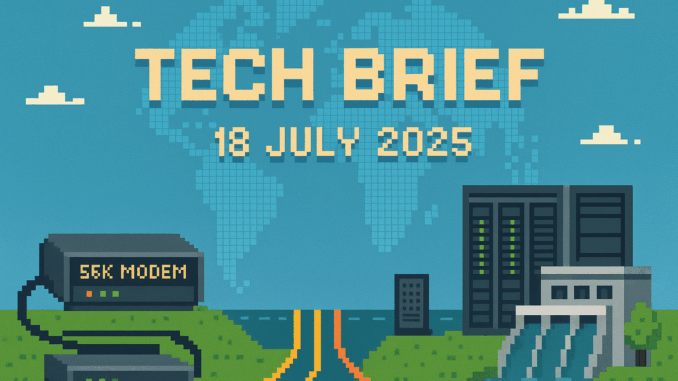
Tech Brief – 18 July 2025 opens with a scene many of us know too well: hunched over the family phone socket, untangling a coiled cable just to get that modem handshake and a precious online connection. For those who recall the whine of a 56k modem or the first time an online game lagged because someone picked up the phone, today’s stories show how the backbone of global tech has grown up, resilient, sprawling, and still vulnerable in all the old ways.
U.S. Moves to Ban Chinese Tech from Subsea Cables
The U.S. Federal Communications Commission (FCC) is preparing to vote on banning Chinese technology from undersea cables that connect the U.S. to the rest of the world. The decision, set for 7 August, targets familiar names like Huawei and ZTE. FCC Chair Brendan Carr points out that submarine cables now carry 99% of global internet traffic. This is not just another round of geopolitics; these cables are the arteries for everything from international gaming lobbies to AI data transfers. The FCC is also inviting public input on extra safeguards. It’s a move that brings to mind the days when USENET admins lost sleep over fragile international links and the odd transatlantic packet loss. For network engineers and anyone who’s ever traced a stubborn packet across continents, the message is clear: digital infrastructure is now a frontline concern, not just a technical footnote. For a deeper dive, see our earlier feature on How Submarine Cables Changed the Web Forever.
Google Signs £2.3bn Hydropower Deal to Power AI Data Centres
Google has signed a £2.3 billion ($3bn) agreement with Brookfield Asset Management to secure 3 gigawatts (GW) of hydropower for the next 20 years. This is now the largest corporate hydropower deal on record and is set to power Google’s expanding data centre footprint across the eastern United States. AI workloads are pushing energy demand to new heights. For context, 3GW could run millions of Amiga 500s simultaneously, enough to overheat every bedroom in Britain. Hydropower’s reliability and scale make it more than a green badge; it’s essential for keeping next-generation servers running without brownouts. Google’s move sets a precedent for other tech giants and serves as a reminder for anyone who remembers the brownouts of the early 90s: the energy behind the cloud is as crucial as the code itself. The unsung engineers maintaining those hydro plants are the modern equivalents of the power supply tinkerers who kept our home micros alive.
Isambard-AI: UK’s Most Powerful Supercomputer Comes Online
Britain’s Isambard-AI supercomputer launched this week in Bristol, delivering a jaw-dropping 200 petaflops of compute power. For comparison, a single petaflop equals one thousand trillion calculations per second; imagine every ZX Spectrum in Britain calculating at once, and you’re still not close. Announced by Technology Secretary Peter Kyle, Isambard-AI anchors a new national AI research initiative. The government aims to reach 420 exaflops by 2030, with a major centre in Edinburgh to follow. For those who marvelled at the BBC Micro’s 2MHz processor, these numbers are almost beyond comprehension. The shift from hobbyist hacking to state-backed computational arms races is real. Isambard-AI’s arrival marks the UK’s intent to stay competitive in global AI research, opening doors for climate modelling, medical breakthroughs, and more. If you want the full story, check out Britain’s Supercomputers: From ICL to Isambard.
Europol Disrupts Pro-Russian Hacktivist DDoS Network NoName057(16)
Europol has dismantled NoName057(16), a pro-Russian hacktivist group responsible for distributed denial-of-service (DDoS) attacks on Ukrainian and European targets. DDoS attacks flood a network with traffic, knocking services offline; think of it as the digital version of everyone dialling into Teletext at once and crashing the system. The operation, announced on 17 July, exposed the group’s coordinated campaigns that align digital disruption with physical conflict. This is not the lone hacker in a bedroom cliché. Instead, it’s more like the coordinated demo scene, but weaponised and state-aligned. The takedown shows how cyber and geopolitical warfare now overlap, with law enforcement using both technical and intelligence-led strategies. If you remember the early days of IRC skirmishes, today’s battles are much larger, with real infrastructure and public trust at stake.
From the Wayback Machine
On This Day: 1968 – Intel Founded by Gordon Moore and Robert Noyce
On 18 July 1968, Gordon Moore and Robert Noyce incorporated Intel, launching with a focus on semiconductor memory and a vision for continuous innovation. Their early work on metal-oxide semiconductor (MOS) memory and silicon gate technology set standards for density and efficiency, paving the way for the first commercial DRAM and microprocessor. Intel’s founding team, including Andy Grove and Arthur Rock, built a culture of technical leadership and collaboration that shaped Silicon Valley’s ethos. Today’s CPUs, cloud infrastructure, and digital economy all stand on the foundation laid by these semiconductor pioneers.
What This Means
Tech Brief – 18 July 2025 demonstrates that digital infrastructure, from cables beneath oceans to supercomputers in Bristol, is a technical and geopolitical battleground. Security, investment, and innovation must work together to keep tomorrow’s networks resilient. For users, the stakes are personal; every online moment relies on this hidden backbone. What’s your most memorable tech infrastructure mishap? Who else remembers their first packet trace?
If you’re choosing between cloud storage and a stack of floppies, remember: every byte needs a backbone, so choose wisely and keep your soldering iron handy.
Missed yesterday’s Tech Brief? Catch up here.

Leave a Reply